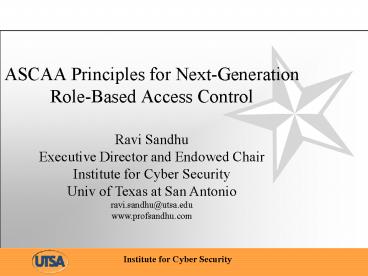ASCAA Principles for Next-Generation Role-Based Access Control PowerPoint PPT Presentation
Title: ASCAA Principles for Next-Generation Role-Based Access Control
1
ASCAA Principles for Next-Generation Role-Based
Access Control
Ravi Sandhu Executive Director and Endowed
Chair Institute for Cyber Security Univ of Texas
at San Antonio ravi.sandhu_at_utsa.edu www.profsandhu
.com
2
The State of Cyber Security
- We are in the midst of big change in cyber space
- Nobody knows where we are headed
- So far we have done a pretty bad job in cyber
security - There is hope
- New services will not be held back
- Need for security will remain
- Good enough security is achievable
3
Security Schools of Thought
- OLD THINK
- We had it figured out. If the industry had only
listened to us our computers and networks today
would be secure. - REALITY
- Todays and tomorrows cyber systems and their
security needs are fundamentally different from
the timesharing era of the early 1970s.
4
Change Drivers
Stand-alone computers
Internet
Vandals
Criminals
Mutually suspicious yet mutually
dependent security
Enterprise security
Many and new innovative services
Few standard services
5
DAC Discretionary Access Control
- The owner decides who gets access
- Anyone with read access can copy and owns the
copy - The classic formulation of DAC is fundamentally
broken - Solving the owner-control problem correctly is
high priority (but a different lecture)
but only to the original
First emerged early 1970s First models early
1970s
6
MAC Mandatory Access Control
- Who gets access is determined by security labels
- A users security label is assigned by a security
officer - Copies are automatically labeled correctly by the
security system
First emerged early 1970s First models early
1970s
7
MAC Mandatory Access Control
TS
S
Lattice of security labels
C
Information Flow
U
8
Orange Book 1983
- There is MAC (good)
- There is DAC (weak)
- Dont need anything else
9
RBAC Role-Based Access Control
- Access is determined by roles
- A users roles are assigned by security
administrators - A roles permissions are assigned by security
administrators - Control on copies determined by configuration of
roles
First emerged mid 1970s First models mid 1990s
Is RBAC MAC or DAC or neither?
10
Fundamental Theorem of RBAC
- RBAC can be configured to do MAC
- RBAC can be configured to do DAC
- RBAC is policy neutral
RBAC is neither MAC nor DAC!
11
RBAC96 Model
ROLE HIERARCHIES
USER-ROLE ASSIGNMENT
PERMISSIONS-ROLE ASSIGNMENT
ROLES
PERMISSIONS
USERS
SESSIONS
CONSTRAINTS
12
Example Role Hierarchy
Director (DIR)
Project Lead 1 (PL1)
Project Lead 2 (PL2)
Production 1 (P1)
Quality 1 (Q1)
Production 2 (P2)
Quality 2 (Q2)
Engineer 1 (E1)
Engineer 2 (E2)
Engineering Department (ED)
Inheritance hierarchy
Employee (E)
13
Example Role Hierarchy
Director (DIR)
Project Lead 1 (PL1)
Project Lead 2 (PL2)
Production 1 (P1)
Quality 1 (Q1)
Production 2 (P2)
Quality 2 (Q2)
Engineer 1 (E1)
Engineer 2 (E2)
Engineering Department (ED)
Inheritance and activation hierarchy
Employee (E)
14
NIST/ANSI RBAC Standard Model 2004
Permission-role review is advanced requirement
Inheritance and/or activation
ROLE HIERARCHIES
USER-ROLE ASSIGNMENT
PERMISSIONS-ROLE ASSIGNMENT
ROLES
PERMISSIONS
USERS
Limited to separation of duties
Overall formal model is more complete
SESSIONS
CONSTRAINTS
15
Founding Principles of RBAC96
- Abstraction of Privileges
- Credit is different from Debit even though both
require read and write - Separation of Administrative Functions
- Separation of user-role assignment from
role-permission assignment - Least Privilege
- Right-size the roles
- Dont activate all roles all the time
- Separation of Duty
- Static separation purchasing manager versus
accounts payable manager - Dynamic separation cash-register clerk versus
cash-register manager
16
ASCAA Principles for Future RBAC
- Abstraction of Privileges
- Credit vs debit
- Personalized permissions
- Separation of Administrative Functions
- Containment
- Least Privilege
- Separation of Duties
- Usage Limits
- Automation
- Revocation
- Assignment (i) Self-assignment, (ii)
Attribute-based - Context and environment adjustment
- Accountability
- Re-authentication/Escalated authentication
- Click-through obligations
- Notification and alerts
17
Usage Control The UCON Model
- unified model integrating
- authorization
- obligation
- conditions
- and incorporating
- continuity of decisions
- mutability of attributes
18
Conclusion
- RBAC is here to stay
- ABAC will still use roles as one attribute
- Attribute-based assignment to roles
- Access control needs agility
- Usage limits
- Automation (self-administration)
- Accountability
- This is already happening
- Our models have fallen behind
- ASCAA principles apply beyond RBAC
- UCON model incorporates ASCAA

